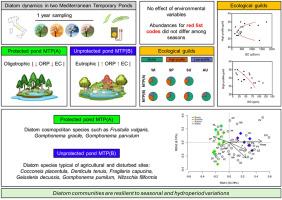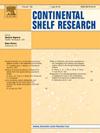Silent survivors: diatom resilience in Mediterranean Temporary Ponds
IF 2.2
3区 地球科学
Q2 OCEANOGRAPHY
引用次数: 0
Abstract
Mediterranean Temporary Ponds (MTPs) are ephemeral freshwater habitats hosting a large number of aquatic and terrestrial organisms. Among these, diatoms represent the bioindicators that contribute mostly to Earth's global primary production. Herein, we focused our attention on the role of seasonality and hydroperiod on benthic diatoms of MTPs. We analyzed the diatom community turnover along one year in two MTPs in the Latium region, Italy. The two MTPs showed different levels of anthropogenic pressures. Our results demonstrated that hydroperiod length and seasonality showed a moderate influence on diatom richness of MTPs; in particular, although the highest number of species was found during spring, taxonomic diversity remained stable at seasonal and inter-annual level despite strong changes in community composition and hydroperiod length. Overall, sampling sites showed different ecological conditions and chemical drivers: protected site was dominated by species occurring in minimally impacted oligo- to mesotrophic waters; unprotected site with high EC and ORP was dominated by species occurring in euryhaline brackish waters. Moreover, physicochemical parameters showed a low influence on diatom assemblages in the protected site and a strong influence in the unprotected site. No significant correlation between diatom ecological guilds and physicochemical parameters emerged. While for all the seasons the dominant guild was the motile guild, no inter-season variations emerged: diatom communities and ecological guilds in MTPs are resilient to seasonal variations. To provide novel insights, future research should focus on additional environmental drivers such as nutrient availability, sediment composition, and hydrological variability, including long-term monitoring plans.

沉默的幸存者:地中海临时池塘中的硅藻恢复力
地中海临时池塘(mtp)是大量水生和陆生生物的短暂淡水栖息地。其中,硅藻代表了对地球全球初级生产贡献最大的生物指标。在此,我们重点研究了季节和水周期对mtp底栖硅藻的影响。我们分析了意大利Latium地区两个MTPs的硅藻群落一年的更替情况。两个MTPs表现出不同程度的人为压力。结果表明:水期长度和季节对mtp的硅藻丰富度有中等影响;尽管群落组成和水期长度发生了较大的变化,但分类学多样性在季节和年际水平上保持稳定。总体而言,各采样点呈现出不同的生态条件和化学驱动因素:受保护地点以受影响最小的中、寡营养水域的物种为主;高EC和ORP的未保护地点以全盐咸淡水中的物种为主。此外,物理化学参数对保护区内硅藻组合的影响较小,而对未保护区内硅藻组合的影响较大。硅藻生态行会与理化参数无显著相关。尽管在所有季节中,主导行会都是移动行会,但没有出现季节间的变化:mtp中的硅藻群落和生态行会对季节变化具有弹性。为了提供新的见解,未来的研究应关注其他环境驱动因素,如养分有效性、沉积物组成和水文变异性,包括长期监测计划。
本文章由计算机程序翻译,如有差异,请以英文原文为准。
求助全文
约1分钟内获得全文
求助全文
来源期刊

Continental Shelf Research
地学-海洋学
CiteScore
4.30
自引率
4.30%
发文量
136
审稿时长
6.1 months
期刊介绍:
Continental Shelf Research publishes articles dealing with the biological, chemical, geological and physical oceanography of the shallow marine environment, from coastal and estuarine waters out to the shelf break. The continental shelf is a critical environment within the land-ocean continuum, and many processes, functions and problems in the continental shelf are driven by terrestrial inputs transported through the rivers and estuaries to the coastal and continental shelf areas. Manuscripts that deal with these topics must make a clear link to the continental shelf. Examples of research areas include:
Physical sedimentology and geomorphology
Geochemistry of the coastal ocean (inorganic and organic)
Marine environment and anthropogenic effects
Interaction of physical dynamics with natural and manmade shoreline features
Benthic, phytoplankton and zooplankton ecology
Coastal water and sediment quality, and ecosystem health
Benthic-pelagic coupling (physical and biogeochemical)
Interactions between physical dynamics (waves, currents, mixing, etc.) and biogeochemical cycles
Estuarine, coastal and shelf sea modelling and process studies.
 求助内容:
求助内容: 应助结果提醒方式:
应助结果提醒方式:


